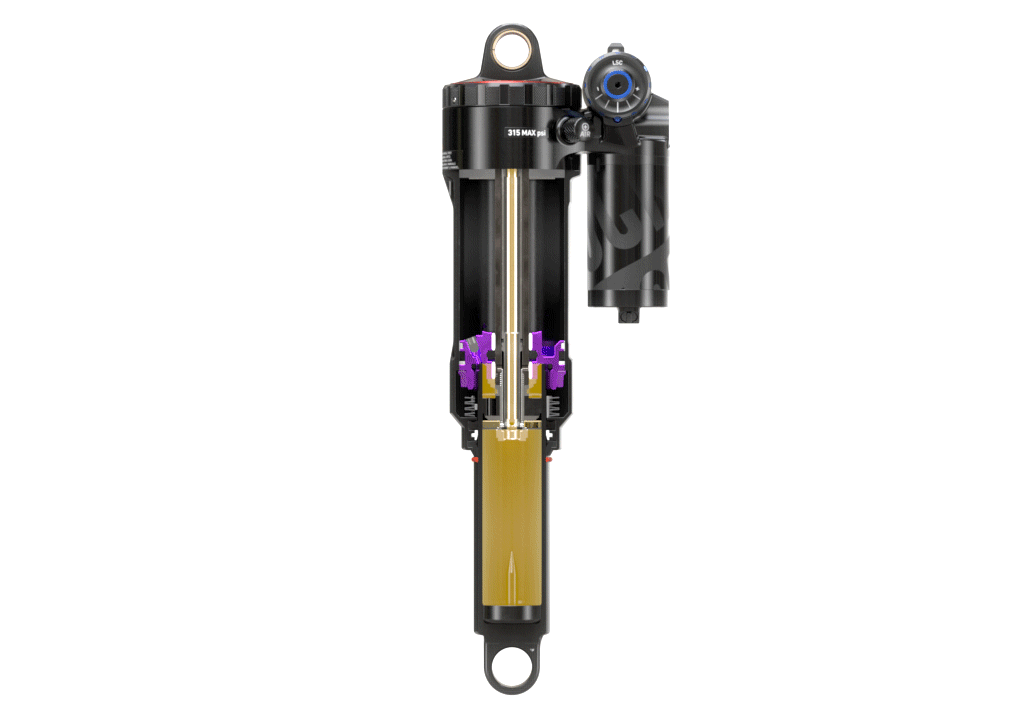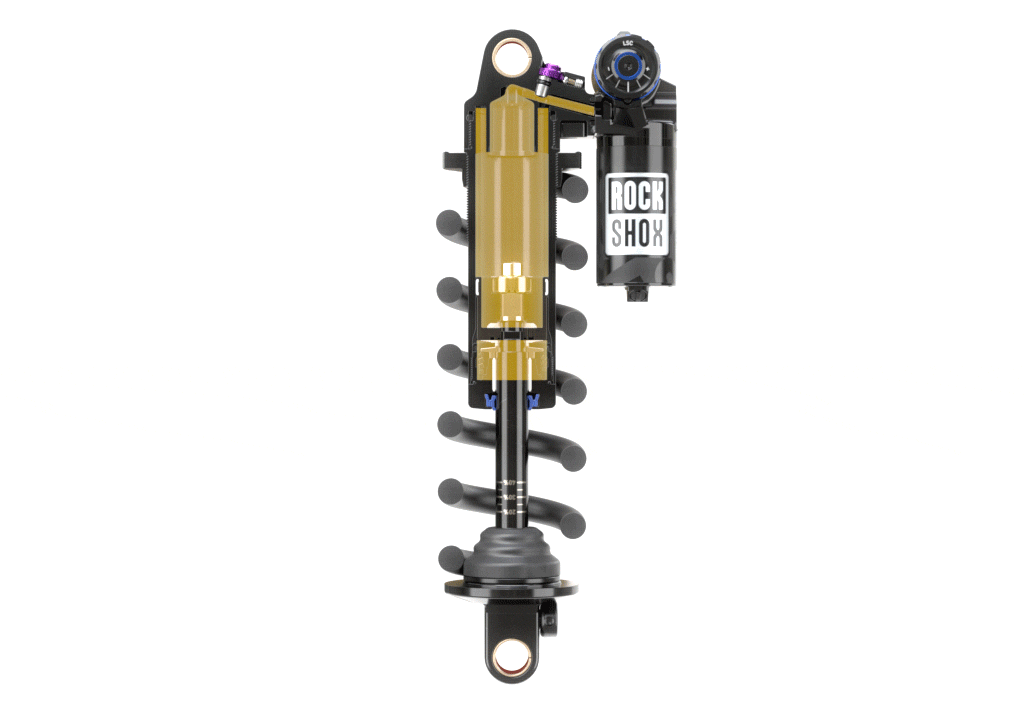REAR SHOCK HYDRAULIC BOTTOM OUT
How Does Hydraulic Bottom Out Work? | Adjustable Hydraulic Bottom Out
If you ride a full-suspension mountain bike on rough terrain, you’ve probably experienced your rear shock bottoming out. It can be a harsh, rattling feeling—sending the impact through your bike and into your body, making you wonder if you bent a wheel or broke a spoke. You can influence how hard and often you bottom out by affecting the spring rate (adding more air pressure or Bottomless Tokens) to the air spring or increasing the coil spring weight. However, we were looking for a way to maintain plushness without sacrificing bottom-out control—cue Hydraulic Bottom Out technology.
Senior Design Engineer Dave Camp has been working on RockShox rear shocks for eight years, and as one of the hardest-riding fellas in the RockShox office, he was looking for a way to smooth out the impact from bottoming out. After running his enduro bike maxed out with tokens and higher-than-average air pressure at the bike park all summer, he wanted to make a design change to reduce the bounce back he would experience from the bike after a hard landing. He had the idea to retrofit a hydraulic needle into his existing Super Deluxe to see if he could affect the last bit of travel and took it back out to the bike park for testing. The prototype showed promise, so Dave and the team set out to implement it in the 2023 lineup of shocks.

How does Hydraulic Bottom Out work?
We refer to Hydraulic Bottom Out as the technology of using oil damping to affect bottom out in the last 20% of travel, but the way we approach that damping between Super Deluxe Air and Super Deluxe Coil/Vivid is different. Super Deluxe Air has a fixed amount of bottom-out resistance, whereas Super Deluxe Coil and Vivid have five clicks of adjustable bottom-out resistance, both options kicking in during the last 20% of travel.

Hydraulic Bottom Out animation
In 2023 Super Deluxe Air shocks with Hydraulic Bottom Out, a needle lives at the bottom of the damper tube, and as the rear shock cycles through the last 20% of travel, that needle enters the damper piston with an orifice port. Similar to the orifice ports found in the High Speed Compression circuits in Charger 3 and RC2T, when that port is blocked, it creates pressure and causes more damping, slowing down the flow of oil and increasing the force needed to reach bottom out. Typically, in the second half of travel, the shock starts to slow down because you’ve already begun to absorb energy, so the shock is compressing slower as you get closer to using full travel.
To control bottom out better, we have this secondary circuit that increases the force as you near full travel, which is a nice hydraulic cushion to prevent you from slamming into bottom out.
–Dave Camp
Now, if you’re wondering how Bottomless Tokens fit in with Hydraulic Bottom Out, you’ll be happy to know that they are designed to work together. Adding Bottomless Tokens decreases the air spring volume, compressing the air molecules to increase pressure as the shock moves through travel. However, tokens also store energy in the air spring and then release it during rebound, which can return that energy to you. Hydraulic Bottom Out works by converting the mechanical energy from a big hit into thermal energy, which is dissipated into the damper fluid.
With Hydraulic Bottom Out, you can still run tokens to affect the spring rate, but you can run fewer Tokens for a more controlled, stable feeling when you use full travel, eliminating the bounce or harshness you’d usually feel.
Adjustable Hydraulic Bottom Out
Super Deluxe Coil’s (and now Vivid's) Adjustable Hydraulic Bottom Out also uses an orifice port featuring a tooled 3 mm adjuster to allow you to tune precisely how much bottom-out resistance you want. AHBO utilizes a Hydraulic Bottom Out chamber and piston. As the shock compresses, the piston moves up into the chamber, pushing oil through the Hydraulic Bottom Out port where the Hydraulic Bottom Out adjuster lives. There are five clicks of adjustment, from fully open (no bottom-out resistance) to fully closed (full bottom-out resistance). When the adjuster is closed, it increases the pressure building in the Hydraulic Bottom Out chamber, causing more damping as the shock enters the last 20% of travel. The theory is the same as what we discussed above with oil damping, just executed differently to accommodate design differences in each of the shocks.

Adjustable Hydraulic Bottom Out animation
During development, the team did extensive testing—not only to verify durability and safety, but also effectiveness. The chart below shows that as the shock moves through travel, the force increases drastically when the adjuster is Closed (the top line), requiring more energy to use the full amount of travel. Each successive line beneath the top line represents the other four clicks until it reaches the Open position (the bottom line) – where there is little bottom-out assistance. Open it up (toward the - ) or close it off (toward the + ), click-by-click, to find the right amount of bottom-out cushion just for you.

The whole goal behind Hydraulic Bottom Out is that you don't notice it—it discretely adds damping, so your ride feels smoother and more in control. Senior Design Engineer Tim Lynch sums it up. "If you've got your token system tuned correctly in an air shock, then you're going to match with the leverage curve of that frame, and you're going to use all the right amount of travel all the time. Before Hydraulic Bottom Out, you would hit a rubber pad after using all your travel. With this new system, you move towards that end of travel until you hit damping, which dissipates that energy—now you just kiss that rubber pad, making for more control and a smoother ride."
Hydraulic Bottom Out is an optional feature in 2023 Super Deluxe, Adjustable Hydraulic Bottom Out is an optional feature in 2023 Super Deluxe Coil, and an included feature in 2024 Vivid. For more questions regarding Hydraulic Bottom Out, visit our FAQ site.

Renderings by Ray Bach. Photos by Nik Emerick and Boris Beyer. Words by Sarah Walter.